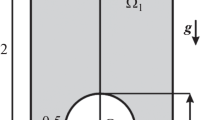Abstract
In connection with our investigations on the motion of gas bubbles rising through a stagnant liquid, experiments were conducted to determine the drag and shape of air bubbles rising freely in water. — A new experimental technique which consists of phototubes, light beams and an electronic circuit has been used to measure the velocity of rise, and the drag coefficient has been determined by equating the buoyancy with the drag. — The size and the deformation of the bubble were determined by a photographic technique. — The results show that, for bubbles rising with a rectilinear motion, theoretical solutions for the drag must be compared with the drag coefficient calculated with the maximum rise velocity, and the results are in good agreement with theory. — There is no wall effect on the rise velocity of the bubble if the ratio of the medium diameter to the equivalent bubble diameter is greater than 18. — Weber number determined according to the maximum velocity is a significant parameter involved in the determination of the shape of air bnbbles. The critical Weber number above which bubbles are not spherical is 0.62, and the bubble surface oscillations begin at the Weber number of 3.70.
Zusammenfassung
In Verbindung mit unseren Untersuchungen über die Bewegung von Gasblasen, die in einer ruhenden Flüssigkeit aufsteigen, wurden auch Versuche zur Bestimmung des Widerstandes und der Form von frei in Wasser aufsteigenden Luftblasen angestellt. — Zur Messung der Aufstiegsgeschwindigkeit wurde eine neuartige Versuchsanordnung benutzt, bestehend aus Photozellen, Lichtstrahlen und einem elektronischen Schaltkreis. Der Widerstandskoeffizient wurde aus dem Vergleich des Auftriebs mit dem Widerstand ermittelt. Größe und Verformung der Blasen wurden photographisch bestimmt. — Die Versuche zeigen, daß für Blasen mit gradliniger Bahn die theoretische Lösung für den Widerstand mit dem Widerstandskoeffizienten verglichen werden muß, der aus der maximalen Aufstiegsgeschwindigkeit berechnet wird. Die Übereinstimmung zwischen Theorie und Versuch ist gut. — Ein Einfluß der Gefäßwand auf die Aufstiegsgeschwindigkeit ist nicht vorhanden, wenn der Gefäßdurchmesser mehr als 18mal so groß ist wie der äquivalente Blasendurchmesser. — Die Weber-Zahl, gebildet mit der größten Aufstiegsgeschwindigkeit, ist maßgebend für die Blasenform. Die kritische Weber-Zahl, oberhalb deren die Blasen nicht mehr kugelig sind, beträgt 0,62, und bei einer Weber-Zahl von 3,70 beginnt die Blasenwand zu schwingen.
Similar content being viewed by others
Abbreviations
- C D :
-
Drag coefficient
- \(C_{D_m } \) :
-
Drag coefficient determined forv z max
- \(C_{D_z } \) :
-
Drag coefficient determined forv z ave
- D :
-
Drag
- Re :
-
Reynolds number determined in terms of the equivalent bubble diameter (Re=vd e/ν l)
- We :
-
Weber number determined in terms of the equivalent bubble diameter (We=d e ϱ l v 2/σ)
- a :
-
Major axis of the ellipse
- b :
-
Minor axis of the ellipse
- d e :
-
Equivalent bubble diameter
- g :
-
Acceleration of gravity
- h :
-
Helix pitch
- m :
-
Mass
- y :
-
Acceleration
- μ l :
-
Dynamic viscosity of the liquid
- μ g :
-
Dynamic viscosity of the gas
- ν l :
-
Kinematic viscosity of the liquid
- ϱ l :
-
Density of the liquid
- ϱ g :
-
Density of the gas
- φ :
-
Helix slope defined by tgφ=h/(πD h)
- σ :
-
Surface tension
- x :
-
Bubble deformation (x=a/b)
References
Shihi-Pai: Viscous Flow Theory, Van Nostrand 1956, pp. 120/121.
Rybczynski, W.: Bull. Int. Acad. Sci. Cracovie, (A) 1911, 40.
Hadamard, J.: Comp. Rend. Vol. 154 (1911) p. 1735.
Boussinesq, S.: Ann. de Chimie et de Phys. Vol. 29 (1913) pp. 364/372.
Levich, W. G.: Physicochemical Hydrodynamics, Prentice Hall 1962, pp. 396/402.
Chan andPrice: A.I.Ch.E.J. Vol. 11 (1965) 176, pp. 188/192.
Moore, D. W.: J. Fluid Mechn. Vol. 6 (1956) pp. 113/130.
Moore, D. W.: J. Fluid Mechn. Vol. 16 (1963) pp. 161/176.
Moore, D. W.: J. Fluid Mechn. Vol. 23 (1965) pp. 749/766.
Allen, H. S.: Phil. Mag. Vol. 50 (1900) pp. 322/338, pp. 519/534.
Miyagi, O.: Tech. Report of the Tohoku Imp. Univ. Vol. 5 (1925) pp. 135/167.
O'Brien, M. P., andS. E. Gosline: Ind. Eng. Chem. Vol. 27 (1935) p. 1436.
Garodetskaya, A. V.: J. Phys. Chem. (USSR) Vol. 23 (1949) pp. 71/77.
Datta, R. L., D. H. Napier andD. M. Newitt: Trans. Inst. Chem. Engrs., London Vol. 28 (1950) pp. 14/26.
Rosenberg, B.: The David W. Taylor Model Basin, 1950, Rep. 727.
Haberman, W. L., andR. K. Morton: The David Taylor Model Basin 1953, Rep. 802.
Davies, R. M., andG. I. Taylor: Proc. Roy. Soc. Vol. A 200 (1950) p. 375.
Peebles, R. N., andH. J. Garber: Chem. Ing. Progress Vol. 49 (1953) p. 88.
Aybers, M. N., andA. Tapucu: The Motion of gas bubbles rising through stagnant liquid. Wärme- und Stoffübertragung Vol. 2 (1969) p. 118–128.
Author information
Authors and Affiliations
Additional information
This research is sponsored by the Turkish Scientific and Technical Research Council.
Rights and permissions
About this article
Cite this article
Aybers, N.M., Tapucu, A. Studies on the drag and shape of gas bubbles rising through a stagnant liquid. Wärme- und Stoffübertragung 2, 171–177 (1969). https://doi.org/10.1007/BF00751164
Received:
Issue Date:
DOI: https://doi.org/10.1007/BF00751164



